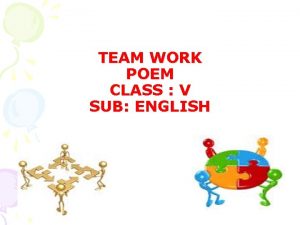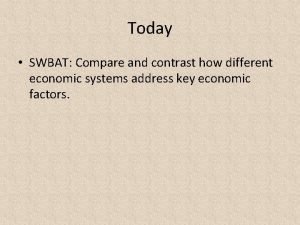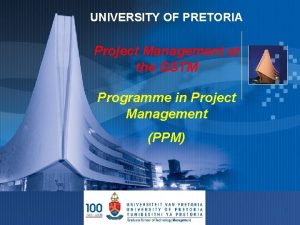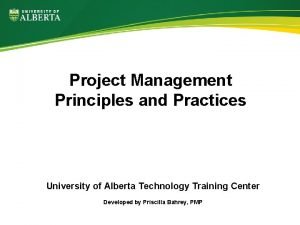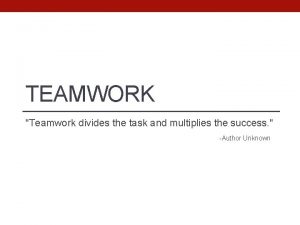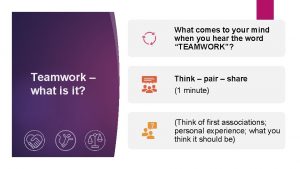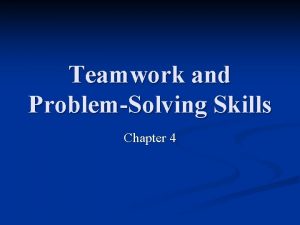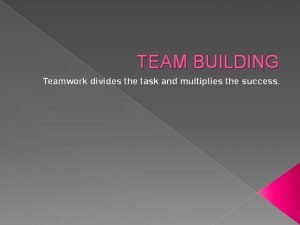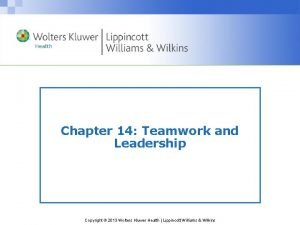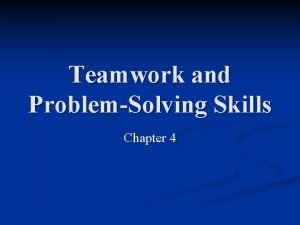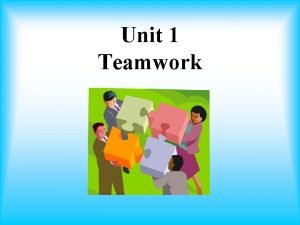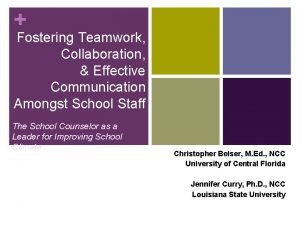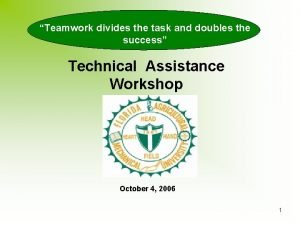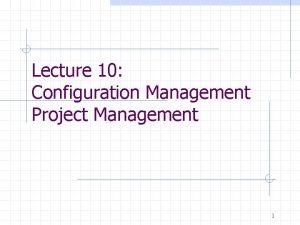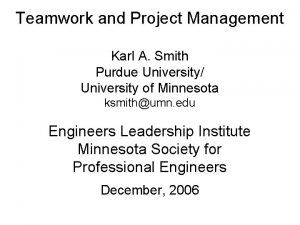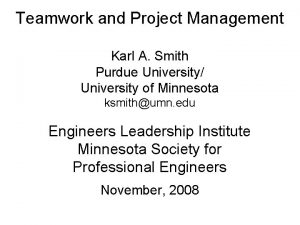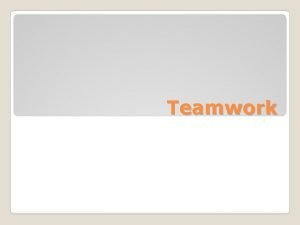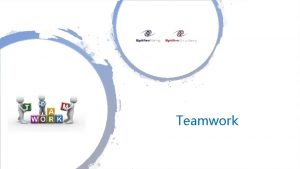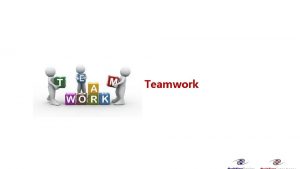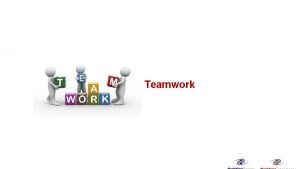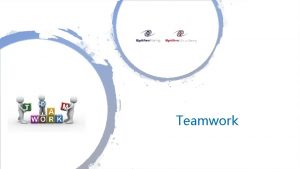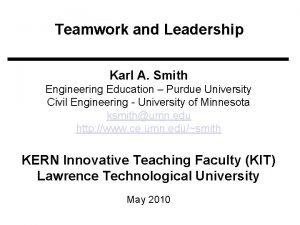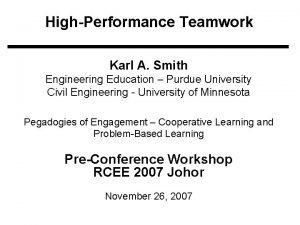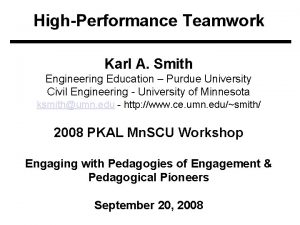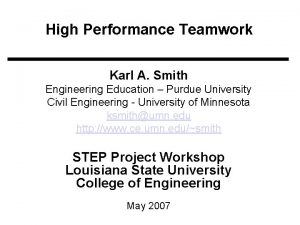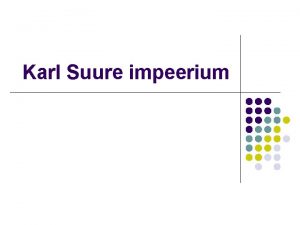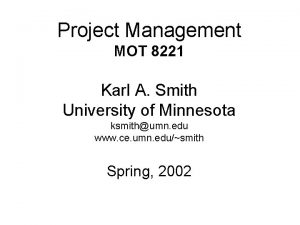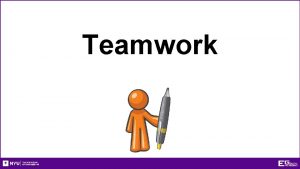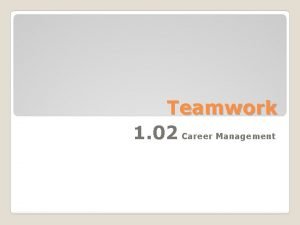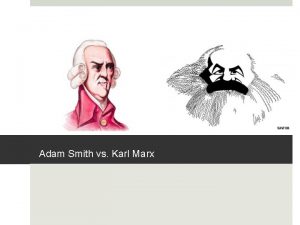Teamwork and Project Management Karl A Smith University
































- Slides: 32

Teamwork and Project Management Karl A. Smith University of Minnesota ksmith@umn. edu www. ce. umn. edu/~smith January 2005 Engineers Leadership Institute Minnesota Society for Professional Engineers

Teambuilding and Project Management Perspectives • Capitalizing on individual differences • Leading a team to consensus; the importance of buy-in • Expanding a team’s capabilities • Perspectives on the role of project manager • Key components to project and/or team success • Project coordination 2

. . . Tomorrow’s corporation is a “collection of projects”. . . Everyone needs to learn to work in teams with multiple independent experts--each will be dependent upon all the others voluntarily giving their best. . The new lead actor/boss--the Project Manager --must learn to command coach; that is, to deal with paradox. From Eight Commandments for Project Managers Tom Peters

In the new economy, all work is project work. And you are your projects! Here’s how to make them all go Wow! Tom Peters – The Wow Project (Fast Company, 24, 116) 4

Project A project is a temporary endeavor undertaken to create a unique product, service, or result -- Project Management Body of Knowledge (PMBOK), 2004 A project is a combination of human and nonhuman sources pulled together in a temporary organization to achieve a specified purpose. -- Cleland Kerzner, 1985 5

What is a project? (Cleland Kerzner, 1985; Nicholas, 1990) • … a combination of human and nonhuman sources pulled together in a temporary organization to achieve a specified purpose. • Features – – – – Definable purpose with established goals Cost, time and performance requirements Multiple resources across organizational lines One-time activity Element of risk Temporary activity Process with phases/ project life cycle 6

The Project Management Body of Knowledge is the sum of knowledge within the profession of project management 7

Performance, Cost, and Time Project Targets 8

Project Success: Quadruple Constraint

Characteristics of ‘Effective’ Project Managers? 1. Formulate your response to the question individually 2. Share your answer with a neighbor 3. Listen carefully to your neighbor's answer 4. Work together to Create a new answer through discussion

What is takes to be a good project manager --Barry Posner (1987) Communications (84% of the respondents listed it) Listening Persuading Organizational skills (75%) Planning Goal-setting Analyzing Team Building Skills (72%) Empathy Motivation Esprit de Corps Leadership Skills (68%) Sets Example Energetic Vision (big picture) Delegates Positive Coping Skills (59%) Flexibility Creativity Patience Persistence Technological Skills (46%) Experience Project Knowledge

Skills necessary for effective project managers -Pinto and Kharbanda (1995): Planning • Work breakdown • Project scheduling • Knowledge of PM software • Budgeting and costing Organizing • Team building • Establishing team structure and reporting assignments • Define team policies, rules and protocols Leading • Motivation • Conflict management • Interpersonal skills • Appreciation of team members' strengths and weaknesses • Reward systems Controlling • Project review techniques • Meeting skills

Project Life Cycle? 1. 2. 3. 4. 5. 6. Wild enthusiasm Disillusionment Total confusion Search for the guilty Punishment of the innocent Praise and honors for the nonparticipants 13

The prevailing view of the project life cycle is that projects go through distinct phases, such as: • • • Conceiving and defining the project Planning the project Implementing the plan Completing and evaluating the project Operate and maintain project A typical construction project has the following seven phases (Kerzner, 1998): 1. Planning, data gathering, and procedures 2. Studies and basic engineering 3. Major review 4. Detail engineering 5. Detail engineering/construction overlap 6. Construction 7. Testing and commissioning

15

16

The Project 50 – Tom Peters Traditional The Project 50 • • Create – 10% Sell – 0% Implement – 90% Exit – 0% 17 Create – 30% Sell – 30% Implement – 30% Exit – 10%

Project Manager’s Role Over the Project Life Cycle: • • • Planning Organizing Staffing Directing Controlling See Smith (2004) p. 67 -68

Project Planning Projects typically start with at Statement of Work (SOW) provided by the client. The statement of work is a narrative description of the work required for the project. A Project Charter is often developed. Planning starts with the development of a Work Breakdown Structure (WBS). A WBS is ‘a deliverable-oriented grouping of project elements which organizes and defines the total scope of a project’ (PMBOK, 1996). There are typically three to six levels in WBSs -- program, project, task, subtask, etc. Developing a work breakdown structure is important for scoping a project, i. e. , determining the specific tasks that have to be completed, choosing appropriate groupings for these activities, and setting precedence and interdependence (what has to follow what and what can be going on at the same time).

www. lewisinstitute. com

Creating a Project Charter 1. Write an Overview of the Project Scope 2. Determine the Team’s Boundaries for Creating the Deliverables 3. Define the Customer’s Criteria for Acceptance 4. Determine the Required Reviews and Approvals 5. Establish Risk Limits 6. Select the Project Leader and Team Members 7. Set Deadlines for Delivery of the Final Deliverables 8. Set Limits on Staffing & Spending 9. Create a List of Required Reports 10. Identify Organizational Constraints & Project Priorities. 11. Assemble a Project Charter Martin, P. & Tate, K. 1997. Project Management Memory Jogger. GOAL/QPC.

charterform. pdf 22

Office Remodeling Project The following activities must be accomplished to complete an office remodeling project: Activity Estimated Duration (Days) Procure Paint 2 Procure New Carpet 5 Procure New Furniture 7 Remove Old Furniture 1 Remove Old Carpet 1 Scrub Walls 1 Paint Walls 2 Install New Carpet 1 Move in New Furniture 1

Office Remodeling Project - WBS Procure Paint Procure New Carpet Procure New Furniture Prepare Remove Old Furniture Remove Old Carpet Scrub Walls Install Paint Walls Install New Carpet Move in New Furniture

Simple Approach for Creating the WBS • Gather Project Team • Provide Team Members with Pad of Sticky-Notes • Team Members Write Down all Tasks They can Think of. • Sticky-Notes Placed and Arranged on Wall 25

26

27

28

Scheduling Problem - CPM Bus Shelter Construction Example Job Name Duration Resources Predecessor(s) 1 Shelter Slab 2 2 5 2 Shelter Walls 1 1 1 3 Shelter Roof 2 2 2, 4 4 Roof Beam 3 2 2 5 Excavation 2 3 6 Curb and Gutter 2 3 5 7 Shelter Seat 1 2 4, 6 8 Paint 1 1 7 9 Signwork 1 2 2, 6

30


Bus Shelter Construction Critical Path Method Results ACT NAME DUR RES LATE EARLY FLOAT ST FN TOT FREE CUR CRIT start PATH 1 Shelter Slab 2 2 2 4 0 0 2 YES 2 Shelter Walls 1 1 4 5 0 0 4 YES 3 Shelter Roof 2 2 8 10 0 0 8 YES 4 Roof Beam 3 2 5 8 0 0 5 YES 5 Excavation 2 3 0 2 0 0 0 YES 6 Curb and Gutter 2 3 2 4 6 8 4 1 2 NO 7 Shelter Seat 1 2 8 9 0 0 8 YES 8 Paint 1 1 9 10 0 0 9 YES 9 Signwork 1 2 5 6 9 10 4 4 5 NO
 Teamwork poem figure of speech
Teamwork poem figure of speech Compare and contrast, karl marx and adam smith venn diagram
Compare and contrast, karl marx and adam smith venn diagram Adam smith vs karl marx
Adam smith vs karl marx Introduction for project
Introduction for project Ppm university of pretoria
Ppm university of pretoria Project management principles and practices
Project management principles and practices University management system project
University management system project The role of project management in achieving project success
The role of project management in achieving project success Walker royce software project management
Walker royce software project management Project cost-duration graph
Project cost-duration graph Introduction to project management kathy schwalbe
Introduction to project management kathy schwalbe What is strategic assessment in software project management
What is strategic assessment in software project management Types of project audit in project management
Types of project audit in project management Agile ms project template
Agile ms project template Types of project termination
Types of project termination Teamwork divides the task and multiplies the success author
Teamwork divides the task and multiplies the success author Qsen core competencies
Qsen core competencies What comes into your mind when you hear the world
What comes into your mind when you hear the world Teamwork and problem solving skills chapter 4 quiz
Teamwork and problem solving skills chapter 4 quiz Teamwork divides the task and multiplies the success
Teamwork divides the task and multiplies the success Chapter 14 teamwork and leadership
Chapter 14 teamwork and leadership Teamwork
Teamwork Teamwork and problem solving terms
Teamwork and problem solving terms Teamwork & collaboration - vocabulary
Teamwork & collaboration - vocabulary Qsen teamwork and collaboration
Qsen teamwork and collaboration Fostering teamwork and collaboration
Fostering teamwork and collaboration Teamwork divides the task and doubles the success
Teamwork divides the task and doubles the success Diagnosis
Diagnosis Asset management vs project management
Asset management vs project management Configuration management project management
Configuration management project management Basic principles of cost management
Basic principles of cost management Software configuration item
Software configuration item Focusing on broad organizational needs
Focusing on broad organizational needs
